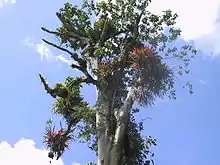In botany phorophytes are plants, on which epiphytes grow. The term is composed of phoro, meaning bearer or carrier[1] and phyte, meaning plant.[2]


Commensalistic interactions
The epiphytes benefit from the habitats provided, but the phorophyte is unaffected. In other words, the obligate epiphytes utilize phorophytes as habitats, without parasitizing them.[3]
Phorophyte specificity
Different phorophytes provide different conditions to the plants, which grown on their surface. The bark pH, degree of bark shedding, the presence of milk sap and the density and size of bark lenticels influence the occurrence of epiphytes.[4] Bark ornamentations affect the establishment os seeds and the chemical composition of the bark may be inhibiting germination.[3] Some epiphytic orchids tend to grow on phorophytes with rough bark. Conservation efforts of orchids need to account for the conservation of phorophytes as well.[5]
References
- ↑ phoro-. (n.d.) Medical Dictionary for the Health Professions and Nursing. (2012). Retrieved March 11, 2022 from https://medical-dictionary.thefreedictionary.com/phoro-
- ↑ -phyte. (n.d.) Collins English Dictionary – Complete and Unabridged, 12th Edition 2014. (1991, 1994, 1998, 2000, 2003, 2006, 2007, 2009, 2011, 2014). Retrieved March 11, 2022 from https://www.thefreedictionary.com/-phyte
- 1 2 Sáyago, R., Lopezaraiza-Mikel, M., Quesada, M., Álvarez-Añorve, M. Y., Cascante-Marín, A., & Bastida, J. M. (2013). Evaluating factors that predict the structure of a commensalistic epiphyte–phorophyte network. Proceedings of the Royal Society B: Biological Sciences, 280(1756), 20122821.
- ↑ Cáceres, M. E., Lücking, R., & Rambold, G. (2007). Phorophyte specificity and environmental parameters versus stochasticity as determinants for species composition of corticolous crustose lichen communities in the Atlantic rain forest of northeastern Brazil. Mycological Progress, 6(3), 117-136.
- ↑ Migenis, L. E., & Ackerman, J. D. (1993). Orchid—phorophyte relationships in a forest watershed in Puerto Rico. Journal of Tropical Ecology, 9(2), 231-240.